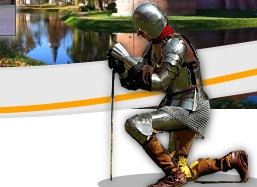| Klaipeda Castle was first mentioned in
a document issued on 29 July 1252. Magister the Great Eberhard
von Zeine agreed with the Kursh Bishop Heinrich on the building
of a castle between two rivers - the Nemunas and the Dange.
It was the same year as the Knights of the Sword built a wooden
castle at the mouth of the Dange River and named it Memelburg.
As the wooden Castle was built in a swampy area, the location
for the construction of a brick castle was chosen to be on
the right shore of the Dange River, where it was plan to develop
the town. Beginning in 1399 major reconstruction work of Klaipeda
Castle under the supervision of the commissioners of the Order
commenced. In 1407 four supervisors of the Order arrived for
"the correction of work". Magister the Great Ulrich
von Jungingen with N. Felenstein, a famous castle builder
also visited the Castle. Architecturally the Castle had no
essential differences from other castles of the Order.
The Castle Museum was inaugurated on August 1st 2002, during
the 750th anniversary celebrations of the city of Klaipeda.
After several decades, the idea, cherished by the leading
figures, archaeologists and historians of the City, to make
the site of Klaipeda Castle accessible to everyone, became
a reality. The Castle Museum is located in the Prince Fredric
chamber under the bastion, where artillery was stored in the
17th century. The Museum's exhibits show the development of
Klaipeda Castle and Klaipeda City during the 13th - 17th centuries.
The Museum has been developed according
to today's standards. The exhibition begins in the tunnel
of the chamber, where exhibits are displayed according to
the different stages of development of the Castle and City
in the 13th - 17th centuries.
The first stand shows weapons and adornments of the Kurshes.
Before the settlement of the Order, the region around Klaipeda
belonged to the Courish Pilsotas land with its own distinctive
and rich culture.
The second stand is devoted to the establishment of Klaipeda,
in which a copy of the Castle Foundation Letter and a scale
model 'The situation of Klaipeda Castle and City in the 13th
century' are displayed. Various household utensils from the
14th - 15th centuries found in Klaipeda Castle, and models
of the Castle and City are displayed in further stands.
Displays devoted to the 16th century contain one of the most
significant exhibits of the Museum, a gold ring inlaid with
a precious stone. Professor Dr. V. ®ulkus determined that
only three such rings, dating back to the middle of the 16th
century, exist: they may have belonged to representatives
from one of the estates (or bishoprics) or they could be articles
of the same jewellery shop.
Renaissance tiles, brewer's accessories and household utensils
are displayed together with the impressive ring. The last
two displays contain blacksmith's and shoemaker's instruments
and articles.The room in the chamber close to the tunnel depicts
a 17th century domestic scene with sitting mannequins dressed
in clothes characteristic of that period. Restored earthenware
found during excavations of the old town and the Castle is
displayed alongside.
An impressive 2 x 2,5 metre model located in the grand room
of the chamber acquaints the visitors with the lay-out of
the City and Castle during the 17th century. Here the preparations
for the repulsion of the Swedish army is depicted as well:
armed soldiers stand near a two-meter long cannon weighing
1 ton, which was found during reconstruction of the bridge
near the site of the Castle. On the other side of the hall,
close to the remains of the 14th century bridge, a mannequin
represents the scene of the reconstruction works of the Castle.
Authentic weapons, wooden tools, household articles from the
16th and 17th centuries and other exhibits are displayed in
the niches of the grand hall. Of special note is the 18th
century authentic silver goblet of the Klaipeda Merchant's
Guild, used only on exceptional occasions. This valuable exhibit
was lent by the Trakai History Museum.
While visiting the Museum it is worth looking around the uncovered
remains of the Castle. Archaeologists have uncovered the foundations
of the building of the 14th - 17th centuries. The foundation
of the Grand Gunpowder Tower is particularly impressive.Visitors
of the Castle Museum can also walk along the oldest roadway
in Klaipeda, dating back to the 16th century, and enjoy a
panorama of Klaipeda from Fredric's bastion.
The Castle Museum
Pilies St. 4, LT-91240 Klaipeda,
tel. 00370 46 41 05 24,
e-mail: info@mlimuziejus.lt
www.mlimuziejus.lt
|






![]()
![]() The
project is co-financed from the funds of the European Regional Development Fund,
under the framework of the Lithuania,
The
project is co-financed from the funds of the European Regional Development Fund,
under the framework of the Lithuania,